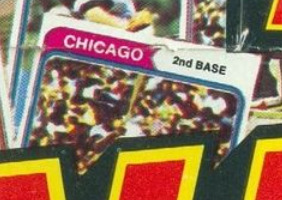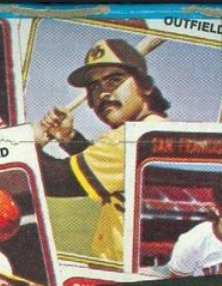In researching my “This Week In 1974 Topps” series I’ve been using transactions listed on Baseball Reference to match 1974 Topps cards up with those transactions. For the most part, it’s been pretty clear cut. You can see that between one November 9th, 1973 deal and another November 14th deal is where 1974 Topps leaves off and 1974 Topps Traded picks up.
This card of Denny Doyle perplexed me, though.

Denny Doyle played the entire 1973 season for the Phillies. You can tell from the zipper-front jersey and Candlestick Park in the background that this photo was taken while he was wearing a Phillies uniform. To make him look a little like he’s with the Angels they airbrushed the crown of his cap, and perhaps covered up the “racing stripes” and Phillies logo on the original uniform.
Denny Doyle’s Baseball Reference page says he was traded to the Angels on December 6, 1973, which would’ve been during the 1973 baseball winter meetings that had taken place between December 3rd and 7th, 1973.
So…?
As I mentioned before, the 1974 Topps set seems to have been “put to bed” in early November, and all of the deals which took place in the winter meetings are reflected in 1974 Topps Traded.
…Except, apparently, for Denny Doyle going to the Angels.
Let’s take a step back and look at the roots of the transaction. On August 14th, 1973 the Angels sent Billy Grabarkewitz to the Phillies for a Player To Be Named Later (or Future Considerations or however else you want to phrase it).
The official transactions say that on December 6th the deal was completed by Doyle going to the Angels and reliever Aurelio Monteagudo and outfielder Chris Coletta going to the Phillies. I found a New York Times article from just after the winter meetings which listed Doyle to the Angels for Monteagudo and Coletta as one of the transactions from those winter meetings (Coletta, BTW, never appeared on a Major League baseball card).
But if that winter meeting deal was Doyle in exchange for Monteagudo, then why is Monteagudo in 1974 Topps Traded while Doyle is in the regular set?

I got out my copy of the sixth edition of The Baseball Encyclopedia; This edition has a transactions section in the back.

The Baseball Encyclopedia’s listing of the trade uses just the original August 14th date of the trade, not the player-to-be-named-later portion… and like I said, Doyle had definitely been traded after the season was over. At the very least his last on-field appearance for the Phils was on September 20th, over a month after the original date.
I did more online searches on Denny Doyle and the Angels. Everything I found indicated that Doyle was traded either “after the season” or during the winter meetings.
But again, we come back to this question: If the 1974 Topps set was finalized in November and Doyle was traded in December, then how is Doyle shown with the Angels?
The back of Denny Doyle’s 1974 card is no help, it makes no reference to the deal. That was far from unusual for that set, though.
At this point fellow hobbyist, published author and professional librarian Matthew J. Prigge offered some help. He found an article from the Detroit News on October 20, 1973 that read as follows:
In the trade rumor department, the only deal that was officially transacted was Pittsburgh second baseman Dave Cash going to Philadelphia for pitcher Ken Brett and second baseman Denny Doyle.
Doyle is reportedly heading to California, which would make Angel second baseman Sandy Alomar available.
My jaw dropped on that description. Yes, there had been a trade where Dave Cash and Ken Brett were involved, but today it’s listed as a one-for-one involving Cash and Brett.


I couldn’t find any other references to Doyle being involved in that transaction… plus, that one trade would’ve placed Doyle on the Pirates roster, there’s no mention of how he would get to California in such a scenario.
I did more research, and kept coming up against that December 6th date. Even the fake newspaper article on the back of Monteagudo’s Traded card implied the same: “The Philadelphia Phillies today completed their deal for infielder Billy Grabarkewitz, acquired from California during the 1973 season, by sending second baseman Denny Doyle to the Angels. In return, the Phillies also received outfielder Chris Coletta and journeyman reliever Aurelio Monteagudo.”
The only explanation I could think of is that Topps had some sort of inside information that Denny Doyle would be an Angel once the Grabarkewitz deal was finalized, and the 1974 Topps card reflected their faith in that inside info.
I finally found one resource which backed up this theory. There’s a Denny Doyle obituary on a website called RIP Baseball and within the obit was this passage:
“The Phillies had claimed veteran infielder Billy Grabarkewitz, who had been hitting .163, from the Angels. At the time, Phillies general manager Paul Owens and Angels general manager Harry Dalton made a handshake deal to trade Doyle after the season. At least, that was how the Philadelphia Inquirer staff described it. The Phillies then traded pitcher Ken Brett to Pittsburgh for second baseman Dave Cash in October, all but guaranteeing Doyle was at the end of his Philadelphia tenure.”
I tried – and failed – to find an online version of the attributed Philly Inquirer article, or any other corroboration of this info. With my resources all but exhausted I decided that this seems as good an explanation as any for the situation… Topps knew that Owens and Dalton had already agreed that Doyle would be part of the deal, but nothing would be official until other details got sorted out. I suppose the Cash/Brett deal might have been originally floated as a three-team trade that fell apart in that particular form.
To complete this epilogue, Denny Doyle was the only player involved in this transaction who brought much value to his new team. Aurelio Monteagudo never pitched in the Majors in 1974 or any season afterwards. Grabarkewitz batted just .133 for the Phils before being sold to the Cubs in July 1974. The remaining piece, outfielder Chris Coletta, played his only Major League games in 1972 and played in Triple-A until 1976.





 ‘
‘













































